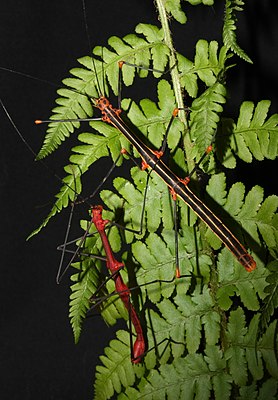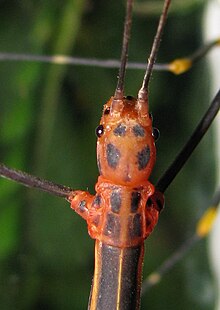Fern stick insect
| Fern stick insect | ||||||||||||
|---|---|---|---|---|---|---|---|---|---|---|---|---|

Pair of the fern stick insect |
||||||||||||
| Systematics | ||||||||||||
|
||||||||||||
| Scientific name | ||||||||||||
| Oreophoetes peruana | ||||||||||||
| ( Saussure , 1868) |
The Fern Stabschrecke ( Oreophoetes peruana ) or, more precisely Peru-Farnstabschrecke is a bright colored species in the order of Gespenstschrecken (phasmatodea). Occasionally it is also referred to simply as a fern or even a fern grasshopper , but this suggests that this species is a grasshopper , i.e. a representative of the long or short-antennae terrors .
features
The females of this very contrastingly colored, wingless species reach a length of 60 to 75 millimeters. The slimmer males remain significantly smaller at 55 to 65 millimeters. Two color forms are known of the females of the subspecies Oreophoetes peruana peruana . While the head, prothorax , knees and hips and the area surrounding them are bright yellow in one, these areas are orange in the other. There are four black spots on the head, of which the two front spots are roughly quarter-circle and the larger, rear spots are roughly the shape of a third of a circle. Together with another dark spot, which is located between the two rear spots and consists of an acute-angled triangle, they form a circle interrupted by a pentagram . On the side of the back of the head, about level with the eyes, there is another triangular spot, so that the head is decorated with a total of seven spots. There are also black spots on the prothorax, of which those on the pronotum form two broad, black longitudinal stripes interrupted by a narrow horizontal stripe. These continued through the meso- and metanotum to the end of the abdomen . In between and to the side there is a thin light yellow stripe, which is followed by a wider black, then again one or two thin yellow stripes and finally the broad, dark belly stripe that becomes lighter towards the end of the abdomen. The antennae , which in the males can reach almost twice the body length, as well as the eyes and the rest of the legs, are colored black. The abdomen of adult , egg-laying females swells significantly in the middle. In the males, in addition to the eyes and antennae, the entire legs are black. The head, thorax, and abdomen are bright red. The black spots and stripes of the females can only be guessed as shadows in the red body color.
Occurrence, way of life and reproduction
The fern stick insect is native to the undergrowth of the mountain forests of Peru. Whether this species also occurs in Ecuador or whether the information about localities there refer to other representatives of the genus is still controversial. The diurnal animals can be found on various fern plants on which they feed. Their striking coloring is an indication of their inedibility. In the event of danger, the nymphs excrete a milky, volatile , pungent-smelling defense secretion from the defensive glands located at the front edge of the prothorax.
Fern stick insects are capable of parthenogenesis . If males are present, the females begin a few weeks after mating to drop one or two, lenticular, very thin-walled, barely three millimeters long, up to 2.5 millimeters wide and an average of 6.3 milligrams eggs on the ground. The 15 millimeter long nymphs hatch from these after eight to twelve weeks. These are already very similar in color to the adult females, whereby the light color components of the orange color variant of Oreophoetes peruana peruana in the nymphs are always yellow (head and legs) or white (longitudinal stripes on the body). From the third nymph stage onwards, a “Y” -shaped spot can be seen on the underside of the last abdominal segment of the females. In the males there is only one black point, if at all. A few hours before molting to the imago , which takes place about three to six months after hatching, the males show an orange color. This is still dominant for a few days after the imaginal molt before it gradually gives way to the characteristic red color.
Systematics
The species was described by Henri de Saussure in 1868 under the name Bacteria peruana . In 1904 it was transferred to the genus Oreophoetes newly established by James Abram Garfield Rehn . In 1898, Ermanno Giglio-Tos described the species Bacunculus festae , Bacunculus festuca and Bacunculus gramen , all of which are now considered synonymous with Oreophoetes peruana peruana , while the Oreophoetes mima, which he described as Bacunculus mimus in the same year, is considered a valid species. In 1875, Samuel Hubbard Scudder described the species Bacteria nigripes , which Oliver Zompro placed in 2002 as a subspecies of Oreophoetes peruana . The holotype of Oreophoetes peruana nigripes , a male from the eastern slopes of the Peruvian Andes , is in the Academy of Natural Sciences in Philadelphia ( ANSP for short ). The lectotype of Oreophoetes peruana peruana , a male from the area of Iquitos , selected by Zompro in 2002 , is deposited in the Muséum national d'histoire naturelle in Geneva .
The following synonyms can be found for the subspecies:
- Oreophoetes peruana peruana ( Saussure , 1868)
- Syn. Bacteria peruana Saussure , 1868
- Syn. Bacunculus festae Giglio-Tos , 1898
- Syn. Heteronemia festae ( Giglio-Tos , 1898)
- Syn. Allophylus peruanus ( Giglio-Tos , 1898)
- Syn. Bacunculus festuca Giglio-Tos , 1898
- Syn. Heteronemia festuca ( Giglio-Tos , 1898)
- Syn. Allophylus festuca ( Giglio-Tos , 1898)
- Syn. Bacunculus gramen Giglio-Tos , 1898
- Syn. Heteronemia gramen ( Giglio-Tos , 1898)
- Syn. Oreophoetes gramen ( Giglio-Tos , 1898)
- Oreophoetes peruana nigripes ( Scudder , 1875)
- Syn. Bacteria nigripes Scudder , 1875
- Syn. Bacunculus nigripes ( Scudder , 1875)
- Syn. Oreophoetes nigripes ( Scudder , 1875)
A species found in November 2007 on the Rio Topo in the Ecuadorian province of Tunguragua was temporarily held for Oreophoetes peruana nigripes . However, this was already recognized as a separate species in 2009 and re-described under the name Oreophoetes topoense .
Terrariums
The first fern stick insects from the vicinity of Tarapoto reached Europe as early as 1984 . The species is listed under PSG number 84 by the Phasmid Study Group .
The fern stick insect should not be kept too warm because of its montane origin. Temperatures between 18 and 22 ° C and a relative humidity of at least 80 percent are ideal. To achieve this, a glass terrarium with small ventilation slots is recommended. In contrast to insufficient humidity, moisture is tolerated well. In addition to pepper plants, all kinds of ferns are eaten . The latter can be placed in the terrarium as complete plants in the flower pot and sprayed with water every day (flower sprayer). When feeding commercial ferns, there is a risk that the animals will poison themselves with insecticides . A thick layer of moss is suitable as a substrate , which should always be kept moist and thus contribute to a correspondingly high level of humidity. The eggs can be left on the floor or transferred to an incubator for better control . Problems with molting of the nymphs, especially the tearing off of legs, indicate insufficient humidity.
photos
swell
- ↑ a b c d Oliver Zompro : Basic knowledge of pasmids - biology - keeping - breeding . Sungaya Verlag, Berlin 2012, p. 61, ISBN 978-3-943592-00-9
- ↑ a b c d Eugène Bruins: Illustrated Terrarium Encyclopedia - Dörfler Verlag, Eggolsheim 2006, ISBN 978-3-89555-423-0
- ↑ Photos, keeping and breeding information on mantisonline
- ↑ a b c Christoph Seiler, Sven Bradler & Rainer Koch: Phasmids - care and breeding of ghost horrors, stick insects and walking leaves in the terrarium - bede, Ruhmannsfelden 2000, ISBN 3-933646-89-8
- ^ Paul D. Brock : Phasmida Species File Online . Version 2.1 / 3.5. (accessed on June 14, 2009)
- ^ Oskar V. Conle , Frank H. Hennemann , Horst Käch and Bruno Kneubühler: Studies on Neotropical Phasmatodea IX: Oreophoetes topoense n. Sp. - a New Colorful Walking-Stick from Central Ecuador (Phasmatodea: Diapheromeridae: Diapheromerinae: Oreophoetini) - Journal of Orthoptera Research 18 (1): 145-152., ISSN 1082-6467 , Online ISSN 1937-2426 ( www.bioone.org )
- ↑ Phasmatodea page by Oskar V. Conle and Frank H. Hennemann ( Memento of the original from May 2, 2011 in the Internet Archive ) Info: The archive link was automatically inserted and not yet checked. Please check the original and archive link according to the instructions and then remove this notice.
- ↑ Phasmid Study Group Culture List ( Memento from December 5, 2012 in the web archive archive.today ) (English)
Web links
- www.tarantelbox.de - Keeping tips for Oreophoetes peruana
- www.phasmidsincyberspace.com - Photos and keeping of Oreophoetes peruana






